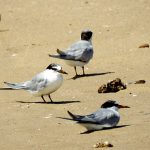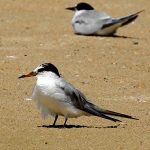LITTLE TERN
The Little Tern is a diminutive bird, with a wingspan of about 50-55 cm and weighing around 50-60 grams. Its plumage is a delicate blend of white and grey, with a distinctive black cap during the breeding season, making it quite the looker on the Australian coastline. It also has a variety of calls.
Our story begins along the vast and varied coastlines of Australia, from the tropical north around Queensland, stretching down the eastern seaboard, around the southern coast, and up the west coast to the mid-western regions. The Little Tern is a migratory bird, with some populations travelling from as far as Southeast Asia and the east coast of China to spend the warmer months (September to April) in Australia for breeding.
The breeding season is a critical chapter in the life of the Little Tern. They prefer sandy beaches, islands, and estuaries for nesting, choosing sites that are above the high-tide mark but close enough to the water’s edge. Here, they lay their eggs in shallow scrapes in the sand, which can make their nests particularly vulnerable to predators and human disturbance. if a predator or threat is perceived, Little Terns have been observed to perform a ‘broken-wing’ display, pretending to be injured to lure the threat away from their nest.
A unique aspect of their breeding is the communal effort in protecting the nests. Little Terns often nest in colonies, and when a predator approaches, they band together, swooping and diving at the intruder in a display of aerial agility and teamwork to defend their future offspring.
The lifespan of the Little Tern in the wild can vary, but they can live up to around 10 years, facing numerous challenges from predators, habitat loss, and human activity. Their survival and longevity are testament to their adaptability and resilience in the ever-changing coastal environments.
Their diet primarily consists of small fish, which they catch with precision by diving headfirst into the water from a height. This hunting technique is a spectacular sight, showcasing their agility and precision.
The story of the Little Tern also carries a message of conservation. Due to their nesting habits and choice of habitat, they are vulnerable to disturbances from human activities, predation, and the impacts of climate change.
The Little Tern’s journey is a reminder of the delicate balance of ecosystems and the importance of conservation efforts to ensure that future generations can also marvel at these agile aviators of the Australian coastlines. Their story encourages us to appreciate the natural world and to act as stewards of the environment, protecting the diverse and beautiful life forms that call Australia home.










